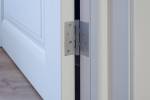Know your woods, laminates before installation
DEAR GAIL: We'd like to replace our carpet with a wood or laminate floor. We understand the basic differences, one's wood and one's not, but beyond that we're lost. What other differences or information should we look for to help make our decision? -- Roger and Kim
DEAR ROGER AND KIM: There are significant differences between wood and laminate. In making your decision you have to consider a couple of things.
First, do you have any pets that really like to run around the house? I'm mainly talking about dogs. Their nails will scratch a wood floor. Do you have a lot of bright sunlight that will be coming into the room where you'll be putting the floor? Although neither is completely fade proof, direct sun will fade wood. With those considerations, let's look at some other things to know when you're comparing products.
There are three types of wood floors: acrylic impregnated wood, engineered wood and solid wood. With an acrylic impregnated wood, acrylics are injected into the wood, which creates a super hard and durable floor. Engineered wood consists of layers of hardwood, plywood or HDF (high density fiber) that are pressed together and glued, with a top layer of hardwood veneer. They run the grain in different directions, which gives it added stability. This added stability allows it to be used in moisture areas such as kitchens and bathrooms. Solid wood is just that, one piece of wood from top to bottom. It can be refinished, but has limitations as to where it can be installed due to moisture.
Laminate is typically made from HDF with a top photographic layer and then finished with a clear coating made from special resin-coated cellulose to protect the laminate flooring. With the advancements in computer-generated images, most times you can't tell a laminate from a wood by just looking at it. But I've found that some laminates can be slippery and do not have as much sound absorption as wood. But they are generally the least expensive.
Now what about durability? For wood floors look for their Janka hardness rating. This lets you know how the product will withstand wearing and dents. It's conducted by measuring the pounds force needed to lodge a .444 steel ball into the wood to a depth of half the ball's diameter. The higher the number, the harder the species. A couple of examples: Brazilian cherry, teak and walnut and Santos mahogany have some of the highest numbers at more than 2,000; Douglas fir has one of the lowest at 600, and maple and oak fall in the middle. You can Google Janka for a complete list.
With laminate you want to look for its thickness and wear rating. The thickness of laminate ranges from 6 mm to 12 mm, with 12 mm being the most durable and therefore also the most expensive. Next is the AC (abrasion class) rating, which was established by the Association of European Producers of Laminate Flooring. Laminates go through a battery of tests for durability, staining, water absorption and burns. AC ratings range from AC1 to AC5, with AC5 being the most durable. Most laminates used in a residential application will have an AC3 rating.
Along with the AC rating, you also want to look for a laminate that has the NALFMA (North American Laminate Flooring Association) seal, which lets you know it has met performance standards.
Although this has nothing to do with which product to select, it's very important to know. Even though we don't live in a high humidity area, the material must be acclimated. This means you have to lay the boxes flat and open in the room where the material is going to be installed. This gets it used to the temperature and humidity in a home. Follow the manufacturer's instructions on how long the wood or laminate must acclimate. I know we're all anxious to get things done, but this is the time to be patient.
I hope this little FYI lesson helps in making your decision.
Gail Mayhugh, owner of GMJ Interiors, is a professional interior designer and author of a book on the subject. Questions may be sent by e-mail to: gail@gmjinteriors.com. Or, mail to: 7380 S. Eastern Ave., No. 124-272, Las Vegas, NV 89123. Her Web address is: www.GMJinteriors.com.





























